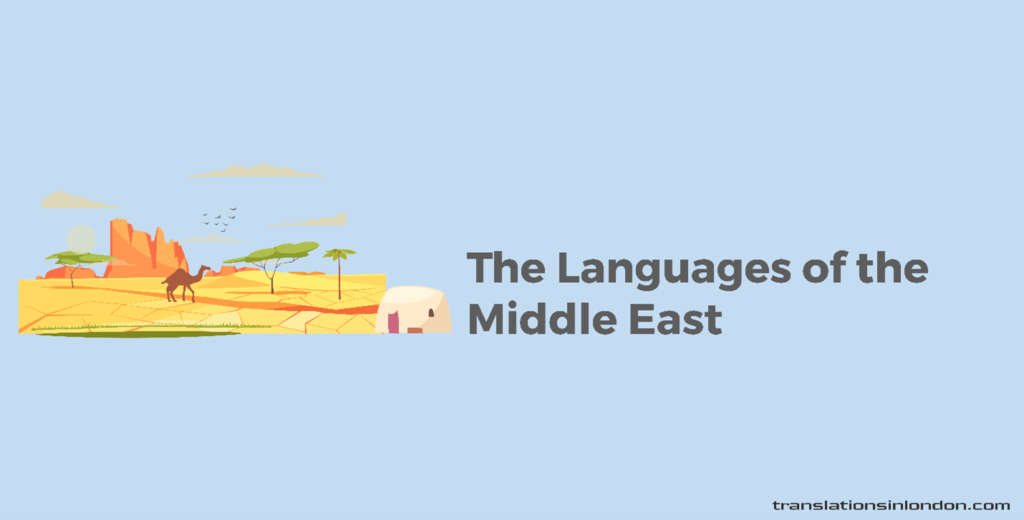The languages of the Middle East

There are several misconceptions about the Middle East, especially when it comes to culture.
A typical example is a popular stereotype about all the people from the Middle East being Arab when in the real sense, it does not reflect the reality.
In fact, only a little more than half (60%) of the total population of the Middle East consider themselves Arab or even speak Arabic!!!
The Middle East is a region that has rich history and diversity with many ethnic groups and languages. And in this week’s post, we would be covering some of these languages.
Where is the Middle East?
Getting to know more about the languages and culture of the Middle East requires some knowledge about its geography, and a good place to start from would be to discern what part of the world is actually called the Middle East.
Geographically, the Middle East cuts across three continents; Parts of Northern Africa, West Asia, and South-Eastern Europe.
A total of 18 countries in these three continents make up the Middle East. But lately, the concept of The Greater Middle East, which spans a more sizable portion of these continents is gradually catching on.
While some of these nations may be homogenous in terms of their language and culture, the same can’t be said for others. That said, let us explore some of the most spoken languages in the Middle East.
What are the main languages spoken in the Middle East?
- Arabic
As we mentioned earlier, Arabic is the most spoken language in the Middle East by a long shot, with over 60% of people from the region speaking it as a first or second language. It is also the fifth most spoken language in the world, with 313 million speakers.
Arabic is part of the Semitic languages and has relations to Hebrew and Aramaic. The language consists of two forms; Classical Arabic — the form in which the Quran (Holy book of the Islamic religion) was written — and Modern Standard Arabic.
Both forms are similar in terms of language structure, but they differ in their groupings, word use, and context.
North African and Asian countries like Egypt, Algeria, Morocco, and Saudi Arabia have some of the most Arabic speakers, but it is possible to find the language spoken in other regions.
Check out our previous post on Arabic to know more about this historic language.
- Persian
Commonly known as Farsi, Persian is the language spoken by the people of Parsi, referred to as modern-day Iran. Farsi is also spoken in some of Iran’s neighboring countries like Afghanistan, Tajikistan, and parts of Uzbekistan, although in different dialects (Dari and Tajik).
Farsi belongs to the
Indo-European family but was heavily influenced by Arabic due to the Muslim conquest of Persia, with many of the Arabic
wordings being localized. The language on its own has also left its mark on
several Indo-Aryan languages. Farsi has over 70 million native speakers spread
across the Middle East and 110 million speakers worldwide.
- Turkish
As the name implies, Turkish is the language spoken in Turkey but also in other countries like Greece, Cyprus, and Bulgaria, which were all part of the Ottoman Empire. Modern Turkish had a lot of inspiration from Persian and Arabic due to the invasion of Anatolia by Turkish tribes way back in the eleventh century.
In fact, Turkish used to be written in an Arabic form before the switch to Latin alphabets in 1928.
Interestingly, some words like; kayak, kiosk, and yogurt are actually of Turkish origins, which have now been borrowed by English.
- Kurdish
Kurdish is yet another language that hails from the Indo-European family, with origins dating as far back as 4000 years ago. It has three main dialects (Northern, Southern, and Central Kurdish) that spread across Iran, Iraq, Turkey, Syria, and Armenia. Most of these main languages (Arabic, Persian, and Turkish) in these regions have left an impression on the way Kurdish is spoken and written.
Today, Kurdish has approximately 30 million speakers around the world.
- Hebrew
Hebrew is an ancient Semitic language just like Arabic, but it is the official language of Israel. Classical Hebrew was the version spoken during the biblical times, but the capture of Jerusalem by the Neo-Babylonian Empire in the 2nd Century CE almost brought an end to the language.
Various movements in the nineteenth century began the revival of the language, with Eliezer Ben-Yehuda leading the charge to modernize the Hebrew language to what we know today.
Presently, there are over 9 million speakers of Modern Hebrew. Although a significant portion is domiciled in Israel, you can still find trace amounts of speakers in Europe and North America.
Other languages spoken in the Middle East include; English, Greek, Russian, Azerbaijani, Urdu, Malayalam, Cherchen, Kazakh, Punjabi, and many more.
Conclusion
Although the five languages covered in this post make up a significant portion of the languages spoken in the Middle East, there are a whole lot more out there, which demonstrates the diversity of this historic region.